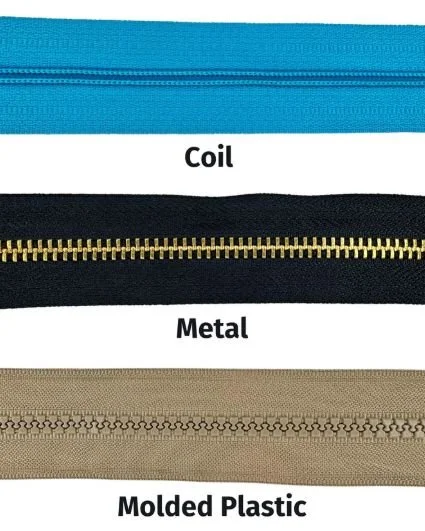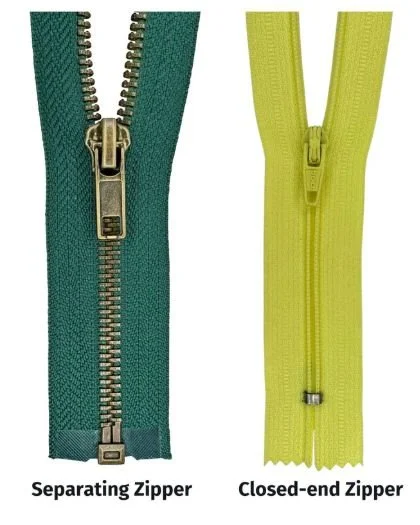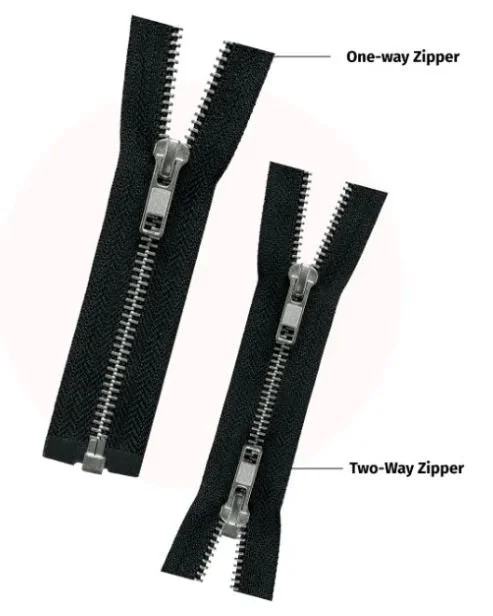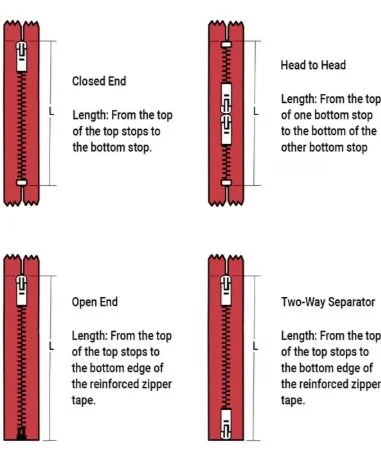Zippers 101: A Designer’s Guide to Choosing and Using Zippers
When Swedish engineer Gideon Sundback introduced the zipper in 1913, he couldn’t have imagined how widely this humble fastening device would shape the future of fashion and function. First embraced by the military and industry, zippers zipped into pop culture when Esquire magazine featured them in 1937, and Levi’s brought them to denim in 1947.
Today, zippers are more than just a practical detail; they’re a design decision. Whether you’re crafting a garment that needs to open fully, designing removable cushion covers, or aiming for a seamless, nearly invisible finish, zippers play a critical role in how a product looks, feels, and performs. Of course, not every sewn item needs a zipper, but when it does, choosing the right one (and using it well) can make all the difference.
Part 1: The Basics of Working with Zippers
Zippers create a secure, adjustable opening and closure that holds fabric pieces together while offering a smooth, user-friendly interface. Their strength and versatility make them ideal for activewear, outerwear, bags, and countless other sewn goods.
How Do Zippers Work?
Zippers operate through interlocking teeth (usually made of metal, plastic, or nylon) that are pulled together or separated via a slider (also called a pull tab or tab). When zipped up, the teeth align in a locked position. When the slider body is pulled down, the teeth disengage, allowing the fabric to open.
The success of a zipper lies in precision: evenly spaced teeth, strong stitching, and the right match between zipper type and garment purpose.
Part 2: Types of Zippers
There are only 3 basic types of zippers used in sewn products, each with unique features and ideal applications depending on the garment, accessory, or upholstery item.
Coil (Nylon) Zippers
Coil zippers are made from coiled nylon or polyester and are known for their flexibility and durability, especially around curves such as pants with zip-off legs. They work especially well in lightweight garments, bags, cushions, and tents, offering a smooth operation even in dusty or gritty conditions. Their soft structure makes them a popular choice for apparel that demands comfort and adaptability.
Metal Zippers
Crafted from materials like brass, aluminum, or nickel, metal zippers are known for their strength and durability. They lend a structured, industrial look that’s ideal for heavy fabrics such as denim or leather. Often found in jeans, leather jackets, and workwear bags, metal zippers are sturdy but can be heavy and less forgiving on delicate textiles.
Plastic Molded Zippers (Vislon)
These zippers feature individually molded plastic teeth and are commonly found in outerwear, sportswear, and backpacks. They're lightweight, often come in water-resistant versions, and offer a smooth glide. However, they may not hold up as well under high tension compared to their metal counterparts, so they’re best suited for moderate use.
Part 3: Characteristics of Zippers
Zippers get confusing because of all the different options/characteristics they can have in addition to being a type. Several different characteristics are listed below.
Separating vs. Non-Separating Zippers
A separating zipper opens fully at the bottom, making it ideal for jackets, hoodies, and coats that require a full front opening.
Closed-end zippers remain attached at the bottom making them perfect for applications where a full opening isn’t needed, such as in pants, skirts, handbags, and some dress designs.
Two-Way Zippers
Designed with two sliders, two-way zippers allow the wearer to open a garment or bag from both the top and bottom. This type is ideal for long coats, sleeping bags, or travel luggage, where added flexibility is necessary. These zippers can be either separating or closed-end, depending on your design needs.
Waterproof or Water-Resistant Zippers
Water-resistant zippers are built with coated tape or sealed seams to keep moisture out. Found in rainwear, wetsuits, and technical outdoor gear, these zippers ensure functionality even in extreme conditions, helping the wearer stay dry without sacrificing design performance.
Reversible Zippers
Reversible zippers have a dual-sided pull that lets users operate them from either inside or outside. Perfect for reversible garments or bags, this type of zipper enhances flexibility and supports creative, functional design choices.
Invisible Zippers
Made with fine nylon coils and sewn into the seam of a garment, invisible zippers live up to their name; they disappear when properly installed, with only the pull tab remaining visible. These are commonly used in dresses, skirts, and formal wear where a clean, seamless finish is essential. They're installed from the inside, making them a go-to for polished and refined designs.
Part 4: Care Tips for Zippers
Proper zipper care starts with thoughtful installation, but continues long after your product is in use. To prolong a zipper’s life:
Avoid catching the fabric in the teeth when zipping
Wash garments with zippers closed to prevent bending or damage
Clean metal zippers occasionally with a toothbrush and soap
Avoid overloading bags or jackets with heavy stress at zipper seams
For waterproof zippers, never apply high heat (dryers or irons) directly to the tape or coating. And always use appropriate zipper length and gauge for your project’s weight and purpose.
Choosing the Right Zipper for Your Design
Choosing the right zipper for your product design involves balancing functionality, aesthetics, durability, and user experience. Here’s a practical guide to help you select the right one:
1. Consider the Product Type and Use
The type of product and your intended use matter when selecting a zipper type. Ask yourself the question: What kind of item am I designing, and how will it be used?
The following is a quick reference to where zippers are best used:
Dresses/skirts - invisible or coil zipper
Jeans - metal zipper
Jackets/coats - separating plastic or metal zipper
Tents/backpacks - coil or molded plastic zipper
Outdoor/waterproof gear - waterproof coil zipper
Reversible garments - reversible zipper
Luggage/bags - two-way coil zipper
2. Determine the Required Strength & Durability
Not all zippers are created equal. Your product’s use and fabric weight should guide your zipper selection.
For heavy-duty items like denim, leather, or utility bags, go with metal or molded plastic zippers; they’re strong and built to last.
For lightweight garments like dresses or activewear, nylon coil zippers offer softness and flexibility without compromising structure.
3. Decide Between Separating vs. Closed-End
Understanding how the item will be used helps you decide which closure style works best.
Separating zippers open completely at the bottom, ideal for garments like jackets and coats that need full removal.
Closed-end zippers stay fixed at both ends and work well for pockets, cushion covers and bags.
4. Choose Based on Aesthetics
Zippers can blend in or stand out depending on the statement you want to make.
Choose invisible zippers when you want the closure to disappear into the seam (perfect for formalwear).
Choose metal or exposed decorative zippers when you want to add an edge or highlight design details.
5. Match the Zipper Length and Size
The zipper you choose must align with both your pattern and your product’s purpose. The style, length, and size matter. When choosing the size of a zipper, you’ll need to measure it in two ways: length and width.
A zipper’s length is measured from the ends of the hardware, not the ends of the tape. In other words, from the top of the slider (when fully closed) to the bottom of the stop (if a closed end) or pin (if open-ended).
The zipper’s width is simply a measure of the width of the teeth. This is in mm and is written as, #3, #5, #7 and so on. You can frequently find a zipper's teeth size marked on the bottom of the zipper slider (the flat side). Look for a number or number-letter combination to determine the zipper's size. For example, on a #5 Nylon Coil Zipper, the slider might say "5" or "5C." Here’s more about measuring zippers.
Zipper Length
Zipper Width (size)
6. Environmental & Special Requirements
The environment your product will live in sometimes matters more than you think.
Raincoats, tents, wetsuits: Go for waterproof or sealed zippers that prevent water from seeping in.
Cold-weather gear: Choose zippers that are glove-friendly and resistant to freezing or corrosion.
Your Quick Zipper Checklist:
Here’s a quick reference to help you confidently choose the right zipper for your design. Whether you're planning for form, function, or both, this checklist keeps your priorities clear during sourcing and production:
Function (open/close method, durability)
Appearance (visible/invisible, color match)
Material compatibility (works with your fabrics)
Length & gauge (proper fit and strength)
Special needs (waterproofing, reversibility)
Design Smarter: Choose the Right Zipper Style for Your Product
A zipper may seem like a small design detail, but it plays a big role in how your product is used, worn, and remembered. By understanding how different types of zippers function — and how they match your materials and goals — you’re making a smarter design decision that improves both form and function.
Need support selecting the right components for your prototype or sample run? Book a consultation to get expert guidance on material sourcing and product development.
For further reading on zippers, check out these additional resources:
> The History Channel: History Erased - Zipper
> Sailrite: Choosing the Right Zipper
> Clover and Violet: Ultimate Zipper Guide: Types and Where to Buy Them Worldwide








